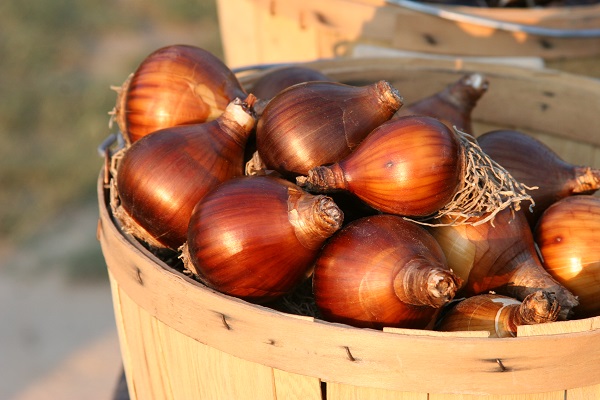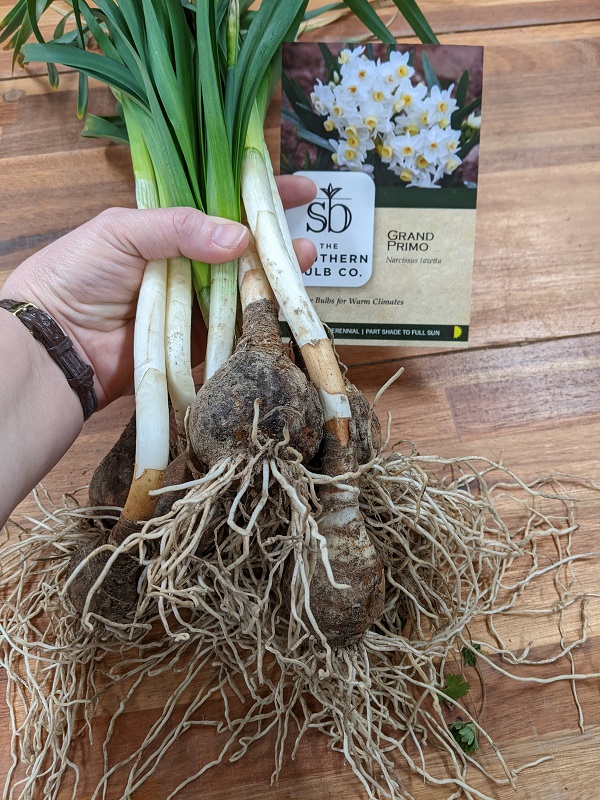

Narcissus tazetta 'Grand Primo' is a superstar from the Gulf Coast to the northern parts of the South, to California, and other warm climates. Vigorous, reliable, perennial all come to mind. Landscapers enjoy the bulb for its massive color impact, and home gardeners enjoy it for the length of bloom time. Each bulb will send up two to three flower stalks, while also propagating and turning into more bulbs. Its landscape qualities and overall ease of use for home gardeners have made it a favorite.

Sometimes mistaken for a paperwhite, the yellow color in the cup of the Grand Primo contributes a sweetness that helps curtail the sometimes overpowering fragrance of a normal paperwhite. The ability of the bulb to resist blooming until late February helps protect it against the danger of earlier frosts of the season. Because of its ability to thrive almost anywhere in the South and its seldom need to be divided, the Grand Primo has won a special place among Southern gardeners.

Large Bulbs
Grand primo daffodils make some of the largest bulbs we have in the Narcissus group of bulbs that we sell. Their ability to make large bulbs is one of the reasons that a single bulb can often send up 2 to 3 flower stalks a season, extending their season of color.

What does “in the green” mean?
In the summer and fall, we ship dry bulbs that many consumers are familiar with. However, in the spring we ship some flower bulbs with their foliage still on them, having dug them right after their bloom. When the customer receives them, the foliage is in the process of drying down naturally. Plant the bulbs, with foliage and all in the ground and let the foliage turn brown and die back naturally. Another option is to not plant the flower bulbs and store the bulbs with the foliage in a cool, dark, and well ventilated spot, and most importantly let the foliage die down naturally. In other words, DON'T cut the foliage of bulbs when you receive them in the green. The browning and dying back of the foliage is the natural process of the bulb sending food and energy from the leaves down into the bulbs for their summer dormancy.
I thought daffodil bulbs are normally shipped in the fall? We grow many of our own daffodils here on our farm, and while it is unconventional in the United States, it is common to have bulbs shipped in the green in other parts of the world. We grow many of our own heirloom daffodils that we originally collected from old gardens on former homesites. Shipping these in the green allows us to:
1) Ship them during the bloom season when most gardeners are thinking of and remembering to plant daffodils
2) Ensures correct identification of the flower bulb. These are heirlooms and buying and receiving the right genetic selections is important to having varieties that are perennials and will naturalize in your garden
3) Allows us to offer more bulbs are lower prices to customers

Remember that bulbs shipped in the green are coming to an end of their growth cycle. You can expect:
1) The foliage to yellow and die down naturally
2) The bulb to be dormant in the summer and early fall
3) Roots to start growing in mid fall
4) Foliage appears next January
5) Bulbs to bloom next February and March
Narcissus tazetta 'Grand Primo' is a superstar from the Gulf Coast to the northern parts of the South, to California, and other warm climates. Vigorous, reliable, perennial all come to mind. Landscapers enjoy the bulb for its massive color impact, and home gardeners enjoy it for the length of bloom time. Each bulb will send up two to three flower stalks, while also propagating and turning into more bulbs. Its landscape qualities and overall ease of use for home gardeners have made it a favorite.

Sometimes mistaken for a paperwhite, the yellow color in the cup of the Grand Primo contributes a sweetness that helps curtail the sometimes overpowering fragrance of a normal paperwhite. The ability of the bulb to resist blooming until late February helps protect it against the danger of earlier frosts of the season. Because of its ability to thrive almost anywhere in the South and its seldom need to be divided, the Grand Primo has won a special place among Southern gardeners.

Large Bulbs
Grand primo daffodils make some of the largest bulbs we have in the Narcissus group of bulbs that we sell. Their ability to make large bulbs is one of the reasons that a single bulb can often send up 2 to 3 flower stalks a season, extending their season of color.

What does “in the green” mean?
In the summer and fall, we ship dry bulbs that many consumers are familiar with. However, in the spring we ship some flower bulbs with their foliage still on them, having dug them right after their bloom. When the customer receives them, the foliage is in the process of drying down naturally. Plant the bulbs, with foliage and all in the ground and let the foliage turn brown and die back naturally. Another option is to not plant the flower bulbs and store the bulbs with the foliage in a cool, dark, and well ventilated spot, and most importantly let the foliage die down naturally. In other words, DON'T cut the foliage of bulbs when you receive them in the green. The browning and dying back of the foliage is the natural process of the bulb sending food and energy from the leaves down into the bulbs for their summer dormancy.
I thought daffodil bulbs are normally shipped in the fall? We grow many of our own daffodils here on our farm, and while it is unconventional in the United States, it is common to have bulbs shipped in the green in other parts of the world. We grow many of our own heirloom daffodils that we originally collected from old gardens on former homesites. Shipping these in the green allows us to:
1) Ship them during the bloom season when most gardeners are thinking of and remembering to plant daffodils
2) Ensures correct identification of the flower bulb. These are heirlooms and buying and receiving the right genetic selections is important to having varieties that are perennials and will naturalize in your garden
3) Allows us to offer more bulbs are lower prices to customers

Remember that bulbs shipped in the green are coming to an end of their growth cycle. You can expect:
1) The foliage to yellow and die down naturally
2) The bulb to be dormant in the summer and early fall
3) Roots to start growing in mid fall
4) Foliage appears next January
5) Bulbs to bloom next February and March